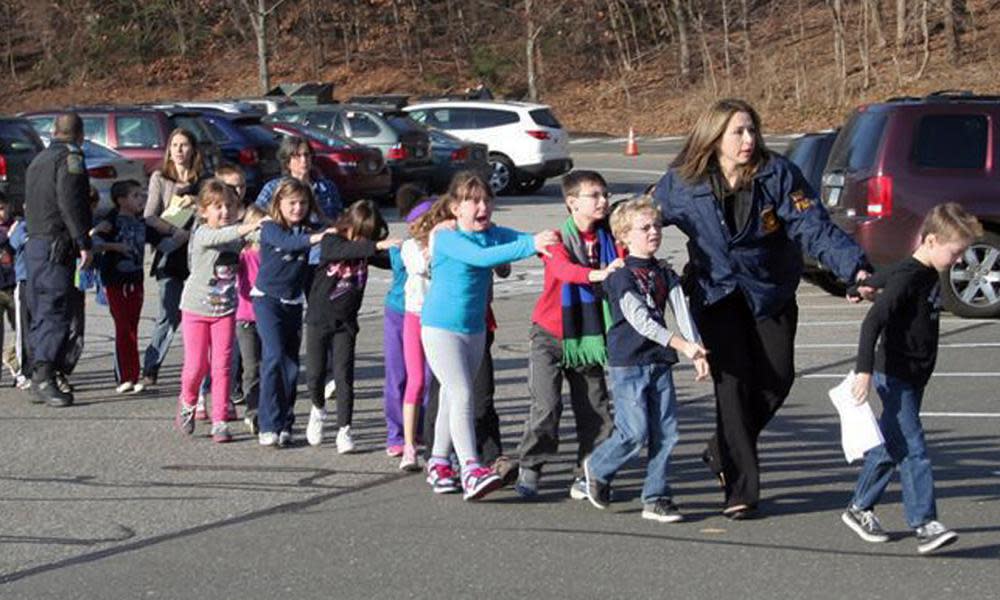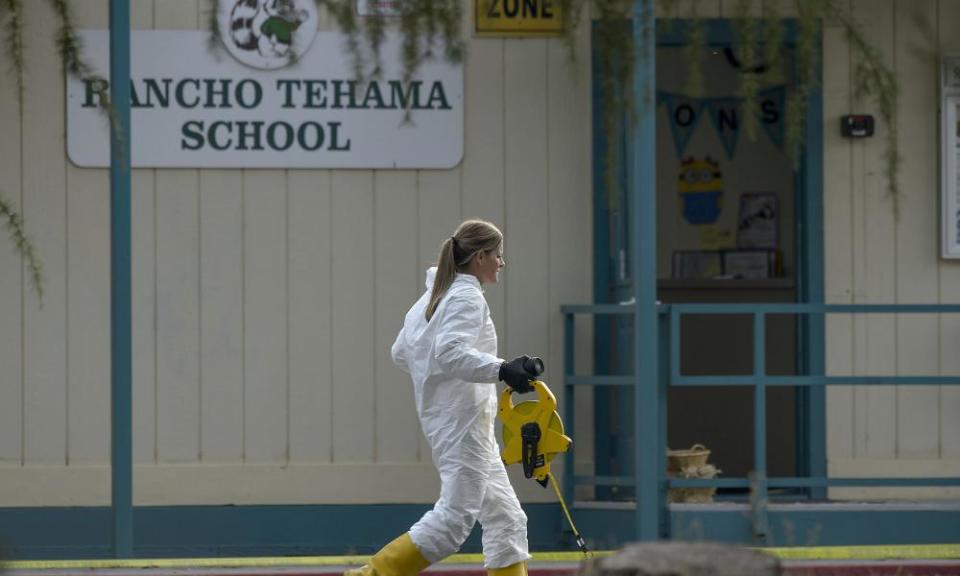America's response to school massacres? A booming classroom security industry

When 16 primary school children were massacred in Dunblane in 1996, the United Kingdom responded by tightening already strict gun laws to ban civilian ownership of handguns.
The United States has responded to nearly 20 years of high-profile school shootings with a booming school security industry. To protect children from potential attackers, companies have offered everything from hi-tech locks for classroom doors to bulletproof whiteboards and backpacks.
Some American schools have even staged fake mass shootings, complete with replica guns, to help their students practice how to respond to an attack. The federal government has spent hundreds of millions of taxpayers’ dollars to put police officers in schools, including $45m in the year after the 2012 Sandy Hook elementary school shooting alone. The market for security equipment in the education sector was estimated at $2.68bn in 2017, according to industry analysts at IHS Markit.
Some kinds of preparation have paid off. When staff at the Rancho Tehama elementary school in California heard gunshots on Tuesday, they quickly put the entire school into lockdown. Police said a shooter rampaging through the rural town spent about six minutes shooting into the school, but that he could not get inside. One student was shot through the wall as children lay on the floor to avoid the gunfire, but was in stable condition. School staff were praised for a quick response that seemed likely to have saved many lives.
But school safety experts say that American schools’ preparation for the next school shooting has sometimes backfired, resulting in policy choices that make children less safe.
The National Association of School Psychologists cautions American schools against preparing for shootings with simulated attacks that could end up traumatizing young students or even the school’s staff.
The group notes in its guidance to schools that “Armed assailants in schools account for only 1% of homicides among school-age youth.”
Basic lockdown drills, like the one the Rancho Tehama school successfully carried out this week, are appropriate, Katherine C Cowan, a spokeswoman for the organization, said. But the group cautions against “full scale simulations of an armed assailant coming into the school building and in effect acting out what to do and what can happen”.
Typically, in these situations, “the person playing the active shooter has a gun” that fires “pellets instead of bullets”.
“That can be extremely traumatizing, particularly for kids, but it can also be traumatizing for staff,” she said. These trainings have “grown exponentially since Sandy Hook,” she said, and “There are some instances that we’ve heard of where people have been physically injured as part of the process.”

Some teachers have raised concerns about the emotional impact of even simple lockdown drills that require young students to hide in their classrooms and remain absolutely silent.
“Instead of controlling guns and inconveniencing those who would use them, we are rounding up and silencing a generation of schoolchildren, and terrifying those who care for them,” a Virginia schoolteacher wrote in 2014, in an op-ed that described her thoughts while hiding with her students in a closet during one of her school’s frequent lockdown drills. “We are giving away precious time to teach and learn while we cower in fear.”
“Zero tolerance” school discipline policies, which gained prominence after the 1999 school shooting in Columbine, Colorado, also resulted in more frequent suspensions, especially for students of color, said Dewey Cornell, a school safety expert at the University of Virginia.
Multiple studies have shown that more students enter the criminal justice system when more police officers are in schools, sparking concern that the attempt to protect American schools from mass shootings had unintentionally fueled a school-to-prison pipeline that disproportionately harmed students of color.
Don Bridges, the president of the National Association of School Resource Officers, said that current best practice emphasized that police officers in schools not play any role in school discipline. He said that problems emerged only when police officers did not have the appropriate training for their role in schools.
Before Columbine, many schools did not even have crisis plans, Bridges said. Now, having a detailed plan of how to respond to threats is mandatory.
But school shooting fears can put a strain on tight law enforcement budgets, as well as on school budgets. After the Sandy Hook shooting, Bridges’ local police chief was asked to put police officers in all the elementary schools. The chief’s response was “He could do that, but then there would be no officers to put on the streets.”
On average in America, “a homicidal shooting occurs in a school about once every 6,000 years, and that’s not a good use of police officer resources,” Cornell said.
After Sandy Hook, experts calculated that expanding school security measures statewide in Florida could cost $100m a year. A report from the American Bar Association cited an estimate that having a police officer in every American school would cost approximately $3.2bn a year.
“Some school security measures are useful and helpful, but not if it means we cut the budget for prevention measures,” Cornell said. “When schools are spending millions of dollars to rebuild the front entrance of school buildings and they have to cut their counseling staff, I don’t think that’s a net gain in safety.”
Cornell said he did not know of any formal regulation of the school security marketplace.
The Florida Christian school made headlines this month for selling $120 bulletproof panels to insert into children’s backpacks at its school store.
“The teachers are trained to instruct the students to use their backpacks as a shield to protect themselves,” the school’s dean of students wrote in an email to CNN.
In 2013, in the wake of the Sandy Hook shooting in Connecticut, a university in Maryland announced it was buying 200 bulletproof whiteboards for classrooms, at a reported cost of more than $60,000.
“For the most part, it’s kind of a third rail to talk about school security,” Cornell said. “If you talk critically of school security it sounds like you don’t want to protect children.”
“School security is important, but it’s not the main way that we want to prevent shootings,” Cornell said. “We would like to prevent shootings before the gunman shows up in the parking lot.

 Yahoo News
Yahoo News 
